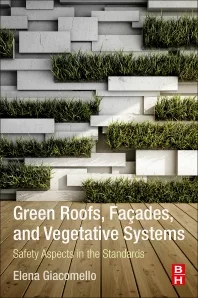Cool Roofing: Green Roofs in the City
The City of Chicago, like many cities, is interested in saving energy and reducing both the heat island effect and wastewater runoff. But instead of simply preaching the virtues of garden roofs, Mayor Richard M. Daley has decided to make it a priority to install them on public buildings, including City Hall, which was capped with a new garden roof in 2001.
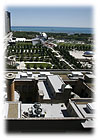
The City of Chicago, like many cities, is interested in saving energy and reducing both the heat island effect and wastewater runoff. But instead of simply preaching the virtues of garden roofs, Mayor Richard M. Daley has decided to make it a priority to install them on public buildings, including City Hall, which was capped with a new garden roof in 2001.
When experts determined the Chicago Cultural Center was in need of a new roof, it seemed like another ideal candidate for a green roof system, as it was another marquee public building in a prominent location. Bordered by Michigan, Washington and Randolph, its rooftop is visible from many surrounding residential and commercial high-rise buildings, and it is situated right next to Millennium Park, a top tourist destination. But the first of many challenges on this project was that the building, designed by the Boston firm of Shepley, Rutan & Coolidge and dedicated in 1897 to serve as the city's main public library, was not designed to support a garden roof, and there was a question as to whether the building could handle the additional weight. Furthermore, the building's ornate inner architecture, which includes intricate plaster ceilings and two stained-glass domes, could not be damaged.
The same high-profile location that made the building a prime spot for a garden roof also posed huge obstacles to its installation. The busy surrounding streets could not be closed to traffic, and events scheduled at the facility would have to continue with as little disruption as possible while the roofing project was completed. The Chicago Cultural Center contains two concert halls, two theaters, and eight exhibition spaces, as well as a cabaret performing space, a senior center, a café, shops, and a visitor center. It hosts over 1,000 programs and art exhibitions every year, so removing the old roof, loading the materials and completing the installation while keeping distractions to a minimum would be a tough goal to achieve.
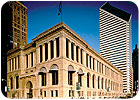
The first step was to conduct a feasibility study to determine if the existing roof could sustain a vegetated roof system. Klein & Hoffman Engineers determined that the building could support the weight, but only if it were strengthened at certain key areas. Josh Dortzbach of Klein & Hoffman explained that the main roof structure incorporated 56-foot spanning steel trusses, which were near their maximum capacity due to the installation of heavy HVAC mechanical equipment in the 1970s.
The key question was how to support the trusses without causing unsightly additions visible above the roof or harming the ornate ceilings on its underside. The engineers at Klein & Hoffman determined the answer was an external post-tensioning system. After holes were cut in the roof and deviator brackets were welded to the bottom of the trusses, high-strength cables were threaded from the high end on each side of the truss. It was determined that with the post-tensioning system, much of the main roof could support the weight of a roof garden, and the engineers, architects, and consultants worked together closely to determine which areas could support the garden roof and which areas - such as the penthouse rooftops - could not.
Once the limitations of the roof were known, the design team explored the possibility of covering as much of the area as possible with a garden roof while maintaining the traditional look of the building. Mary Farlander, project director at BauerLatoza, noted the final design included not only extensive roof garden elements but an irrigation system, solar heating for domestic hot water, and an intricate drainage system comprised of copper scuppers. Due to the constraints imposed by the use of the building, the heavy pedestrian and vehicle traffic and the close proximity of residential condominiums, Mark Lundgren of Alsan quickly ruled out the use of hot asphalt and developed specifications for a roof system that could stand up to the demands of the garden roof system and function equally well - and remain aesthetically pleasing - in areas where it would be left exposed.

Shah saw the garden roof proposal as both an opportunity and a challenge. This was no ordinary low-slope commercial roof; the building's 35,000 square feet of roof surface includes eight different levels, mechanical equipment and intricate details, as well as a 5-foot cornice roof that runs around the outside of the building beyond the parapet wall.
Anderson & Shah began removing the old roof system in late 2005 so structural reinforcement could begin. Several layers of old roofing material had to be carefully lowered five stories with a hoist, which was set up along the building's west side, on Garland Court. Phase one of the project also involved cutting 45 holes in the roof to provide access for engineers and workers from other trades to provide structural support, plumbing, electrical work, and the irrigation system for the garden roof. These holes were installed complete with curbs and flashing, which had to be removed after the work was completed. These areas were decked over to blend in without a trace with the rest of the system when work was completed.
Based on preliminary core cuts, Shah and Lundgren knew what they would be dealing with below the several layers of old roofing material: the original concrete "book tile" deck. To this they applied Ruberoid® Torch Smooth modified bitumen from GAF Materials Corp., which served as a temporary roof while the structural support, masonry work, and plumbing and electrical systems were completed.
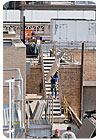
The main roof system was comprised of heavy-density (25 psi) 1-inch isocyanurate insulation set in the OlyBond adhesive. This was topped with 1/2-inch Georgia-Pacific DensDeck, also set in OlyBond, and three plies of Ruberoid Modified Bitumen SBS Heat-Weld Smooth from GAF Materials Corp. In areas that were left exposed, such as penthouse roofs, Ruberoid SBS Heat-Weld Granulated was used. This same granulated white torch-down system was also used for walkways around the perimeter and those that allow access to the mechanical systems and HVAC units. The walkways were completed with walking pads made from recycled rubber.
The 5-foot-wide cornice roof ringing the perimeter was roofed independently. Isocyanurate and DensDeck were installed using SpotShot, and GAF's self-adhered white 60 mil Freedom® TPO was specified as the outer membrane due to its ease of application and aesthetics. Great care had to be emphasized on the so-called "eyebrow" roof, which was outside the parapet wall, and the detailed safety plan called for harnessed workers to be tied in to a steel cable system. Both employees and their tools were tied off at all times, so nothing could endanger the workers or people below the jobsite.
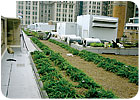 For the roof garden, a 10-mil polyethylene root barrier was installed, which was topped with a fabric drainage mat and growth media. The irrigation lines, which run up from the basement and loop in the attic, are connected to tubes that soak the soil. The system is controlled by a solenoid timer in the basement, and it is maintenance free, except for the need to be drained in winter. The plants, which include junipers, sedum, creeping thyme, and scarlet bee balm, were installed by Berry Landscaping.
For the roof garden, a 10-mil polyethylene root barrier was installed, which was topped with a fabric drainage mat and growth media. The irrigation lines, which run up from the basement and loop in the attic, are connected to tubes that soak the soil. The system is controlled by a solenoid timer in the basement, and it is maintenance free, except for the need to be drained in winter. The plants, which include junipers, sedum, creeping thyme, and scarlet bee balm, were installed by Berry Landscaping.
Eighteen solar panels from Solargenix - some of them strategically placed on HVAC units on the building's north end - are now heating the building's water, and stub frames are in place so panels can be added in the future if desired. The copper scuppers and drainage system were in place as workers wrapped up final details the job at the end of August in preparation for a ribbon-cutting ceremony.
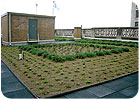
Mark called the Chicago Cultural Center green roof project "just another example of the city putting its money where its mouth is." He pointed out that the result was not only fiscally responsible, but beautiful as well. "It's a showcase and it will always be a showcase," he said. "We're lucky to have worked on it."
Shah agreed. "It was challenging due to all the details, the different elevations, working in confined spaces, working on the edge of a cornice roof - all in the heart of downtown Chicago. But it was exciting, as this is what we should all be doing more of. Not only are these roofs environmentally friendly, they save energy and cut utility costs. They also make a tremendous difference in the quality of life for the people inside the building. I'm privileged to have been a part of it."

The City of Chicago, like many cities, is interested in saving energy and reducing both the heat island effect and wastewater runoff. But instead of simply preaching the virtues of garden roofs, Mayor Richard M. Daley has decided to make it a priority to install them on public buildings, including City Hall, which was capped with a new garden roof in 2001.
When experts determined the Chicago Cultural Center was in need of a new roof, it seemed like another ideal candidate for a green roof system, as it was another marquee public building in a prominent location. Bordered by Michigan, Washington and Randolph, its rooftop is visible from many surrounding residential and commercial high-rise buildings, and it is situated right next to Millennium Park, a top tourist destination. But the first of many challenges on this project was that the building, designed by the Boston firm of Shepley, Rutan & Coolidge and dedicated in 1897 to serve as the city's main public library, was not designed to support a garden roof, and there was a question as to whether the building could handle the additional weight. Furthermore, the building's ornate inner architecture, which includes intricate plaster ceilings and two stained-glass domes, could not be damaged.
The same high-profile location that made the building a prime spot for a garden roof also posed huge obstacles to its installation. The busy surrounding streets could not be closed to traffic, and events scheduled at the facility would have to continue with as little disruption as possible while the roofing project was completed. The Chicago Cultural Center contains two concert halls, two theaters, and eight exhibition spaces, as well as a cabaret performing space, a senior center, a café, shops, and a visitor center. It hosts over 1,000 programs and art exhibitions every year, so removing the old roof, loading the materials and completing the installation while keeping distractions to a minimum would be a tough goal to achieve.

OVER 100 YEARS OLD: It once served as the city's main library, but now the Chicago Cultural Center contains two concert halls, two theaters, and eight exhibition spaces, as well as a cabaret performing space, a senior center, a café, shops, and a visitor center.
Design and Testing
The team assembled for the project included area businesses R.M. Chin and Associates, which served as the architectural/engineering design and construction manager on the project, architect BauerLatoza Studios, Klein & Hoffman Engineers, roof consultant Alsan Group, and roofing contractor Anderson & Shah.The first step was to conduct a feasibility study to determine if the existing roof could sustain a vegetated roof system. Klein & Hoffman Engineers determined that the building could support the weight, but only if it were strengthened at certain key areas. Josh Dortzbach of Klein & Hoffman explained that the main roof structure incorporated 56-foot spanning steel trusses, which were near their maximum capacity due to the installation of heavy HVAC mechanical equipment in the 1970s.
The key question was how to support the trusses without causing unsightly additions visible above the roof or harming the ornate ceilings on its underside. The engineers at Klein & Hoffman determined the answer was an external post-tensioning system. After holes were cut in the roof and deviator brackets were welded to the bottom of the trusses, high-strength cables were threaded from the high end on each side of the truss. It was determined that with the post-tensioning system, much of the main roof could support the weight of a roof garden, and the engineers, architects, and consultants worked together closely to determine which areas could support the garden roof and which areas - such as the penthouse rooftops - could not.
Once the limitations of the roof were known, the design team explored the possibility of covering as much of the area as possible with a garden roof while maintaining the traditional look of the building. Mary Farlander, project director at BauerLatoza, noted the final design included not only extensive roof garden elements but an irrigation system, solar heating for domestic hot water, and an intricate drainage system comprised of copper scuppers. Due to the constraints imposed by the use of the building, the heavy pedestrian and vehicle traffic and the close proximity of residential condominiums, Mark Lundgren of Alsan quickly ruled out the use of hot asphalt and developed specifications for a roof system that could stand up to the demands of the garden roof system and function equally well - and remain aesthetically pleasing - in areas where it would be left exposed.

EYEBROW ROOF: Safety precautions were paramount on the cornice roof, which runs along the building's perimeter. Here a worker puts down OMG's OlyBond 500 SpotShot adhesive before the insulation is installed.
Out With The Old
A registered professional engineer, Paul Shah is fascinated by Mayor Daley's proposal for increasing the number of garden roofs in Chicago. Shah has completed work on several vegetative roof systems in the area, including green roofs on two schools and a Home Depot, and the first Wal-Mart in Chicago. He was thrilled to get the nod to work on the Chicago Cultural Center project. "It's close to my heart to be involved in energy-saving projects, and I want to be a part of this movement to build more garden roofs," he said. "We need to make this a priority in order to reduce the heat island effect and save energy."Shah saw the garden roof proposal as both an opportunity and a challenge. This was no ordinary low-slope commercial roof; the building's 35,000 square feet of roof surface includes eight different levels, mechanical equipment and intricate details, as well as a 5-foot cornice roof that runs around the outside of the building beyond the parapet wall.
Anderson & Shah began removing the old roof system in late 2005 so structural reinforcement could begin. Several layers of old roofing material had to be carefully lowered five stories with a hoist, which was set up along the building's west side, on Garland Court. Phase one of the project also involved cutting 45 holes in the roof to provide access for engineers and workers from other trades to provide structural support, plumbing, electrical work, and the irrigation system for the garden roof. These holes were installed complete with curbs and flashing, which had to be removed after the work was completed. These areas were decked over to blend in without a trace with the rest of the system when work was completed.
Based on preliminary core cuts, Shah and Lundgren knew what they would be dealing with below the several layers of old roofing material: the original concrete "book tile" deck. To this they applied Ruberoid® Torch Smooth modified bitumen from GAF Materials Corp., which served as a temporary roof while the structural support, masonry work, and plumbing and electrical systems were completed.

MULTIPLE LEVELS: The 35,000 square feet of roof surface includes eight different levels, mechanical equipment and intricate details, including two inner stained-glass domes.
The Roofing System
Phase two of the project began in earnest in the spring with the installation of the new roof system. As asphalt had been ruled out and the book tile deck would not allow the use of mechanical fasteners, Lundgren specified the use of OlyBond 500®, a two-part polyurethane insulation adhesive developed by OMG Roofing Products. The adhesive is available in two configurations, in bulk for large jobs and in smaller containers called SpotShot for smaller jobs and tight spaces; both would prove useful on this project.The main roof system was comprised of heavy-density (25 psi) 1-inch isocyanurate insulation set in the OlyBond adhesive. This was topped with 1/2-inch Georgia-Pacific DensDeck, also set in OlyBond, and three plies of Ruberoid Modified Bitumen SBS Heat-Weld Smooth from GAF Materials Corp. In areas that were left exposed, such as penthouse roofs, Ruberoid SBS Heat-Weld Granulated was used. This same granulated white torch-down system was also used for walkways around the perimeter and those that allow access to the mechanical systems and HVAC units. The walkways were completed with walking pads made from recycled rubber.
The 5-foot-wide cornice roof ringing the perimeter was roofed independently. Isocyanurate and DensDeck were installed using SpotShot, and GAF's self-adhered white 60 mil Freedom® TPO was specified as the outer membrane due to its ease of application and aesthetics. Great care had to be emphasized on the so-called "eyebrow" roof, which was outside the parapet wall, and the detailed safety plan called for harnessed workers to be tied in to a steel cable system. Both employees and their tools were tied off at all times, so nothing could endanger the workers or people below the jobsite.

GREEN THUMB: Junipers, sedum, creeping thyme, and scarlet bee balm have already been planted in the new roof garden, which features its own irrigation system.
Eighteen solar panels from Solargenix - some of them strategically placed on HVAC units on the building's north end - are now heating the building's water, and stub frames are in place so panels can be added in the future if desired. The copper scuppers and drainage system were in place as workers wrapped up final details the job at the end of August in preparation for a ribbon-cutting ceremony.

GREEN THUMB: Junipers, sedum, creeping thyme, and scarlet bee balm have already been planted in the new roof garden, which features its own irrigation system.
Teamwork Pays Off
In the end, it was teamwork and coordination that proved the most important element of the project. Weekly meetings were held involving the design and construction team and members of Chicago's Department of General Services, as well as other city departments. Albert Mark, deputy commissioner of the Department of General Services, and John Albrecht, the department's assistant commissioner, stated that despite all of the logistical challenges, traffic was not disrupted by street closures and the Cultural Center was not forced to cancel any events. They credited all of those involved in the project with going above and beyond the call of duty, including sister city agencies that worked together smoothly to handle issues with permits, cranes, hoists and traffic and safety concerns. "The whole project could not have been possible without the help of two green commissioners, Michi E. Peña and Sadhu Johnston," said Albrecht, who noted they all took their cues from "the greenest mayor in the universe."Mark called the Chicago Cultural Center green roof project "just another example of the city putting its money where its mouth is." He pointed out that the result was not only fiscally responsible, but beautiful as well. "It's a showcase and it will always be a showcase," he said. "We're lucky to have worked on it."
Shah agreed. "It was challenging due to all the details, the different elevations, working in confined spaces, working on the edge of a cornice roof - all in the heart of downtown Chicago. But it was exciting, as this is what we should all be doing more of. Not only are these roofs environmentally friendly, they save energy and cut utility costs. They also make a tremendous difference in the quality of life for the people inside the building. I'm privileged to have been a part of it."
Looking for a reprint of this article?
From high-res PDFs to custom plaques, order your copy today!



